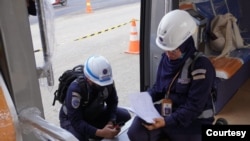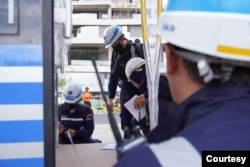When Indonesia marks its 79th Independence Day this Saturday, it will not only be showcasing its ambitious plans to build a new capital more than 1,200 kilometers from the crowded city of Jakarta, but new trackless train technology built by China.
According to organizers, those who attend the celebrations in Nusantara on Saturday will be shuttled around on the country’s first autonomous rail transit, or ART. The trackless trains are just one way that Indonesia is looking to build a smart, green new capital at Nusantara by 2045.
"Our target is to have 80% of land transportation use public transport to activate people’s mobility," said Silvia Halim, deputy of Facilities and Infrastructure at IKN Authority. IKN is the nickname of the new capital city, Ibu Kota Nusantara, or Capital City Nusantara.
The trackless trains are also the latest sign of deepening collaboration between Indonesia and China, Indonesia's largest trading partner and second-largest investor.
Indonesia’s Transportation Minister Budi Karya Sumadi first proposed using Chinese autonomous trains at Nusantara during a meeting with his Chinese counterpart, Li Xiaopeng in Beijing last January.
Earlier this month, Indonesia began testing the autonomous trains in Indonesia’s future capital. The trains will run for a trial period from Independence Day until December 31, 2024, Indonesian officials say.
The self-driving ART system is a cross between a bus and a three- or five-car unit tram and can travel 25 kilometers after a 10-minute charge.
The 32-meter-long trams run on electricity and have no overhead wires, no conventional tracks, and no driver. They are guided by dotted lines on the road and fitted with sensors that follow virtual rails that adapt to the train’s surroundings.
The train sets at Nusantara were sent over from Qingdao, China, in July and will run on a 7-kilometer route at a maximum speed of 40-70 kph. The tram can carry up to 250 passengers.
During a test run at Nusantara, President Joko Widodo compared the ART system and the escalating cost for Mass Rapid Transit and Light Rail Transit systems, telling a meeting of governors, mayors and regents the ART is cheaper and costs about $4.7 million per unit for three carriages.
Indonesia has relied on China for its first high speed railway, replacing some of its commuter line trains and now the ART system. The use of autonomous trains also aligns with Indonesia’s plans for Nusantara to become a smart and green city.
Transportation Minister Budi has said that in the future the autonomous train series will continue to operate at Nusantara. However, its operation will use a so-called buy the service, or BTS scheme. He has also invited the private sector to get involved in the project at Nusantara by purchasing the trains from China and allow the government to run the service.
Budi has said that the establishment of trackless train system in Nusantara is partly a testing ground to expand for use across the country. It is also in line, he said, with the Indonesian government’s hopes to establish an efficient transit system that reduces emissions by 2045.
However, Djoko Setijowarno, a transportation analyst, tells VOA, that replicating a trackless train system in other cities could be challenging as the government must decide whether an ART is regulated as a road vehicle or as a train. He added that authorities must also study how social behaviors on the road affect the safe use of an ART, particularly in traffic congested areas.
"There are still many Indonesian cities that still do not have a good public transportation system. Many people must rely on private vehicles to go everywhere. I think we shouldn’t overburden the state budget with procuring fancy and expensive autonomous rail transit vehicles first, but rather build a Bus Rapid Transit system which is more affordable for regional governments," Djoko told VOA in an online interview.
Trackless trains are not the only way that China is participating in Indonesia’s plans for its future capital.
Since 2023, Shenzen City has been involved in the design planning with the Nusantara Capital Authority. According to Basuki Hadimuljono, the acting chief of the Nusantara Capital Authority, China is also planning to further invest in building housing, hotels and office buildings.











